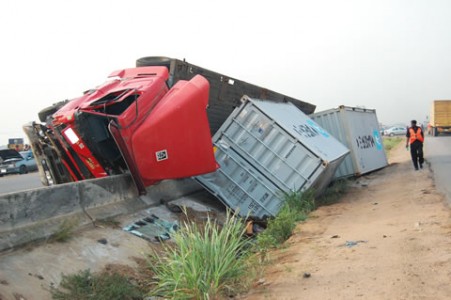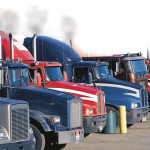
Trucking is a very dangerous profession. In the US where ample data abounds, record has it that over 800 drivers die each year in highway accidents. In Nigeria, the fatalities would be expectedly much higher. On the average, you hear of at least 5 accidents every other week and this number is just for those that made it to the tabloids!
Driving certain types of rigs like tankers and flatbeds is probably the most dangerous major occupations anywhere in the world including Nigeria.
More than half the driver fatalities occur in rollover accidents (rollover accidents being rigs or tankers or flatbed falling on their back or summersaulting)
Another 2/5 occurs in fuel oil fires.
If you avoid these two types of fatal accidents, you can reduce the chances of getting killed on the job by almost 2/3!
Now, here’s how:
FUEL OIL FIRES
Diesel fuel is hard to ignite, but when you have 500 litres or so on board it can make a real mess out of the driver and the rig if it catches fire following an accident. Research suggests that a large energy source is required to ignite even warm diesel oil (the fuel in the tanks is heated by recirculation through the pump).
You probably can’t ignite a large diesel leak from a ruptured tank with sparks or by hot surface ignition (like an exhaust manifold). The most likely ignition source for a fire following a rollover or collision is the battery box. If you short out or crush the batteries following a tank rupture you may get a large fire. If you can’t get out of the rig you had better hope the rollover or collision killed you; otherwise it could get real ugly in that cab if you’ve got a large diesel fire under it.
What Experts suggest: MOVE the BATTERIES! Put them behind the cab in front of the fifth wheel, or inside the frame rails so that the frame rails protect them- if there is room there. Get a good electrical mechanic to do this for you in either case, and make sure he checks for interference if you decide to put them inside the frame rails. If you can’t move the batteries, put a cage around the box; make it out of heavy gage angle iron or steel tubing. Don’t weld the cage to the frame rail! This will ruin the heat treatment and the rail will break. Bolt it on. The idea is to prevent the batteries from being crushed and/or shorted out in an accident.
RIG ROLLOVERS
Big rigs (Truck and trailer of any kind) roll easily. Your rig can probably rollover going around a corner or in a variety of other maneuvers involving steering. If you go around a curve too fast, you will go over, but you probably already knew this. Here are some things you may not know:
You can rollover in a curve without going too fast for the curve if your rear tyres strike something (like a curb) while you’re cornering. Articulating vehicles (5th wheel type) with rubber tyres outrack when turning above a certain minimum speed, typically 45km/hr. This is inherent to the vehicle and not the result of poor driving. Your trailer axle might be 2 feet outside your steering axle if you’re pulling a long trailer. Picture this: You’re coming down a freeway steep slope, turning right (a right hand curve). Your left front tyre might be 1′ inside the fog line while your outer left rear tyre might be 1′ outside the fog line. What’s out there to trip you and turn you over?
You can probably roll your rig at speeds as low as 25km/hr especially on slopes or where a strong tripping influence is present. You can roll backing up if you’re jackknifed.
Many rollovers happen when drivers try to return to the road after putting a tyre off the pavement. You can rut in soft ground or catch a pavement separation here and go over. If you put a wheel off the pavement or even onto a paved shoulder that may have separations, straighten the rig out and bring it to a stop. Don’t try to return to the road at speed. Get out of the rig, carefully inspect the site and determine that you can get back on the road without catching or tripping a tyre before you move out again. If you do decide to drive it back on, return to the road as slowly as possible and at as shallow an angle as possible. The more steer you put in the easier it is to go over. If it looks too bad, call a towing vehicle! We are not kidding here, we know that thousands of drivers have gone off the road and come back without rolling the rig, but hundreds of others have also tried and died in the attempt.
Treat any load that can move on you like a load of dynamite and drive accordingly.
Shippers who insist on running tankers less than 3/4 full are putting you under unnecessary risk. Many have died on account of sloshing traceable to poor load distribution.
Lane changes and similar road maneuvers can roll you; this goes double for double drivers and triple for triple drivers.
Surviving a Rollover
Sometimes the trailer or the load will prevent the roof from contacting the ground when you do a 180 degree roll (1/2 turn), you’re better off here, but no guarantees. Without a high trailer or load, if you roll 180 degrees or more and put the tractor on its roof it will collapse down to the engine line. Headache racks and cargo barriers will not save you; they’re too low and too weak. If you stay in the cab and remain upright you will probably get killed.
Some drivers have saved themselves by jumping out of the rig before it goes over. This might work for an opposite side roll but it is hard to recommend this technique. If you roll left (same side roll) and you jump or fall out, the rig may rollover on top of you. A number of drivers are killed each year in 90 degree rollovers when they fall out of the cab and the rig rolls over on them. Evidently the door opens and they fall out because they’re not belted up. (Make sure both doors are locked when you’re moving) If you jump out the high side you are in danger of hitting your head on the pavement or suffering some other injury from the fall. This is still probably better than staying upright in the cab IF the rig does a 180 or more. The problem is that you don’t know how far it’s going to roll. A high van will generally prevent you from going all the way over if the van itself survives the ground contact. Flat beds and tankers roll easier and roll farther once the wheels come off the ground.
If the vehicle is not going over onto its top then you are better off belted up in the cab, but move away from the strike surfaces and watch out for the doors. If it is going over onto its top,get downin the cab. If you get below the hood line you will probably avoid getting killed. This works in conventional trucks where there is some room.
The problem here is the seat belt. You are better off with the belt on in any kind of accident except for a rollover greater than 90 degrees. In this situation the belt may impede your efforts to get down out of the way of the collapsing roof. You may be able to slip out of the shoulder harness or disconnect the belt however. Learn where that buckle is, practice reaching for it with your right hand so you can release it quickly while pulling yourself down with your left hand once you decide to get out of the way. Big rigs don’t roll that quickly, you will have some time to act if you are prepared and know what to do.
When do you start thinking about saving your life and not the rig?









How best can you drive around a big truck. We have heard of a slow moving rigs even stagnant ones tripped and fall over cars beside it. Trailers sometimes roll back from a hill to crush cars/vehicles behind them.
Immagine being stranded in a traffic only for a truck coming downhill to lose its brake or control. What caution can a small vehicle driver take to avoid trouble?
How best can you drive around a big truck. We have heard of a slow moving rigs even stagnant ones tripped and fall over cars beside it. Trailers sometimes roll back from a hill to crush cars/vehicles behind them.
Immagine being stranded in a traffic only for a truck coming downhill to lose its brake or control. What caution can a small vehicle driver take to avoid trouble?
@Adekunle Mojeed; Thank you for creating time to visit our blog. We really do value and appreciate your interest in what we are doing. In answer to your question and observations, kindly check this post out: https://haulagereportnow.com/getting-by-in-the-midst-of-many-trucks/
The referenced post which we uploaded about a week ago is something we can all learn from. Big rigs on the road isn’t really a phenomenom to abhor. We only need to exercise due caution whenever we are around them. Some of the cautions we need to observe are well articulated in the video. Please do check it out. Thank you.
The article is very interesting and educative. Please keep the good works on.
@Remi Odufeko; Thank you for the commendation sir. We will keep up the good work as adviced. We appreciate and look forward to receiving more comments on other stories and referrals to this haulage-centric first-of-its-kind website in Nigeria!